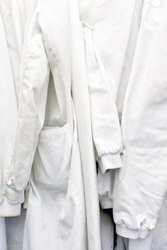Don't Dress for Disaster: Why Lab Coats are Your Laboratory Lifeline
21st Feb 2024
The laboratory is a hub of scientific exploration, a place where groundbreaking discoveries are made and the boundaries of knowledge are pushed. But within this realm of intellectual pursuit lies a potential for physical hazards. From the caustic bite of chemicals to the insidious spread of pathogens, laboratories demand a culture of safety. And a vital component of that safety culture? The humble lab coat.
Lab coats might seem like a simple garment, but they serve a multitude of purposes, acting as your first line of defense in the laboratory. Let's delve deeper into why wearing a lab coat is not just recommended, but essential:
1. Shielding Yourself from Spills and Splashes:
Laboratory experiments often involve working with liquids, some of which can be hazardous. Accidents happen, and a misplaced pipet or a sudden jolt can lead to spills. In such scenarios, a lab coat acts as a barrier, protecting your skin and clothes from the harmful effects of chemicals. Acids, bases, and other corrosive agents can cause burns and irritation upon contact. Lab coats, typically made from a blend of cotton and polyester, offer some level of protection against these threats. While not a substitute for proper splash protection like gloves and goggles, they can provide valuable time to remove contaminated clothing before serious injury occurs.
2. Minimizing Cross-Contamination:
Laboratories can be breeding grounds for contaminants, both biological and chemical. Bacteria, viruses, and even trace amounts of chemicals can cling to clothing fibers. Wearing a lab coat helps to contain these contaminants within the laboratory environment. This is particularly crucial when working with sensitive experiments or sterile materials. By putting on a clean lab coat upon entering the lab and removing it before leaving, you minimize the risk of transferring contaminants to other areas or experiments.
3. Protecting Your Personal Belongings:
Laboratory chemicals can wreak havoc on your clothes. Acids can bleach fabrics, while organic solvents can leave permanent stains. Regular clothing is simply not designed to withstand the rigors of the laboratory environment. A lab coat acts as a sacrificial layer, shielding your personal attire from accidental exposure to chemicals and other hazards. This not only saves your favorite shirt from a chemical bath, but also reduces the risk of harmful substances being carried outside the lab on your clothes.
4. Promoting a Culture of Safety:
The act of wearing a lab coat serves as a constant reminder of the importance of safety in the laboratory. It reinforces the notion that you are working in an environment that requires a heightened level of caution. Seeing everyone around you in lab coats fosters a sense of collective responsibility for safety, encouraging everyone to be mindful of their actions and the potential hazards present.
5. Maintaining Professionalism:
Lab coats project a professional image. They signify that you are a trained scientist working in a controlled environment. This is particularly important when visitors are present in the lab or when collaborating with colleagues from other departments. A professional appearance fosters trust and demonstrates a commitment to proper laboratory protocols.
Beyond the Basics: Choosing the Right Lab Coat
Not all lab coats are created equal. When selecting a lab coat, consider the following factors:
- Material: Cotton-polyester blends offer a good balance of comfort and protection. For specific applications, consider flame-retardant or water-resistant materials.
- Length: Lab coats come in various lengths. Knee-length coats offer more comprehensive protection, while shorter ones provide greater mobility.
- Closures: Buttons or zippers are common closure options. Zippers offer a tighter seal but may be less convenient.
- Pockets: While excessive pockets can be cumbersome, a few well-placed pockets can be handy for storing pens, notebooks, or small tools.
Remember: Lab coats are just one component of a comprehensive laboratory safety program. Always wear appropriate personal protective equipment (PPE) such as gloves, goggles, and respirators, as required by the specific experiment.
The Final Word
Lab coats are more than just a uniform. They are a vital safety measure that protects you, your colleagues, and your research from harm. So, the next time you step into the laboratory, don't forget to don your lab coat – it might just be your scientific lifeline.
Cenmed offers big savings on their lab coats! Contact us today to learn more about how we can help you achieve your healthcare supply chain goals.
(732) 447-1100 // info@cenmed.com

